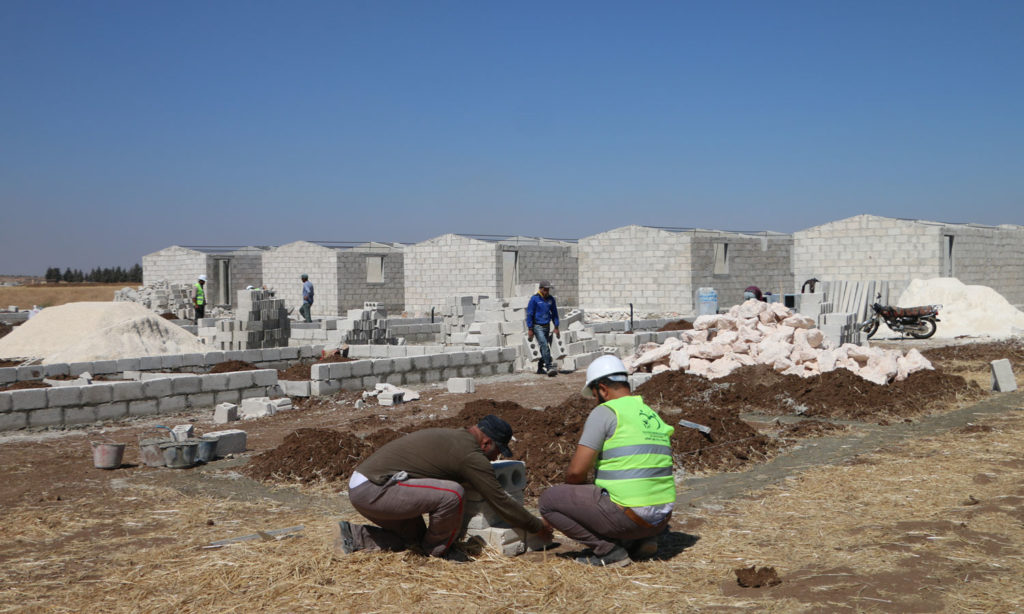Enab Baladi – Abdul Salam Majan
“I have the right to live in a house; I do not want a palace nor a tent.” This is the simple wish of al-Hajj Ahmed al-Saleh, who is originally from al-Sferah town in eastern Aleppo countryside and currently living in the “al-Marj” camp for internally displaced people (IDP) in the town of Ihtimalat, east of Aleppo province.
Al-Saleh, a father of 12 children, was displaced from his town nine years ago. He has been living in the “al-Marj” camp for the last four years, where he opened a shop inside the camp to help him cover his house expanses.
He hoped to move from his tent to the concrete housing units recently built by humanitarian organizations in northern Aleppo.
Unfortunately, his hopes were not realized due to the stone-walled residential villages’ special conditions, which often give priority to orphans, during the first stages of the project.
Several humanitarian organizations and bodies in northern Syria sought to establish new camps, whether concrete housing units or makeshift tents, that are better than the present ones.
Moreover, many residential villages were established in the countryside of Idlib and Aleppo, while construction works continue to meet the needs of the newly displaced people.
Idlib and Aleppo
In rural Idlib, the “Bonyan Organization” has launched a project to establish six new camps to shelter the IDPs. These camps are expected to accommodate about 2,500 families, according to what the project official, Ahmed Qattan, said to Enab Baladi.
The project will be centered in the areas of Isqat, Koknaya, Kafr Bani, al-Sheikh Bahar, and Kafr Takhareem in northern Idlib countryside, in addition to one camp in Afrin area, northern Aleppo.
The camps will be fully equipped with sewerage and drinking water systems.
The camps will provide a water heating system and organized main streets within the camps’ areas.
As for the eastern and northern countryside of Aleppo, Abdul Wahab Mohammed, the director of the “Rahma Humanitarian Foundation” in northern rural Aleppo, said to Enab Baladi that they had started a brick-built housing village project near Bahorta village in northern Aleppo countryside.
This project is in partnership with the “Binaa Organization for Development,” under the name “Rahma Residential Building.”
Mohammed added that the number of housing units to be built is about 100 for the people living in makeshift informal camps according to specific criteria agreed upon between the executors and the local council.
Currently, the project is in the phase of constructing the last ten housing units. Then the units will be equipped with roofs, doors, and windows, water, and sanitation systems, besides other services, including the establishment of a medical point, a school, and a mosque.
Who owns the land?
According to Qattan, the land on which the camps are built is either a public state property for which the building work has been licensed by local councils or a private property, whose owners have donated after checking the land ownership through the area’s cadastre.
Qattan added that the beneficiaries selection mechanism would be through conducting questionnaires in the informal settlements of the same area of the camps, to ensure the anticipatory adaptation of the IDPs to the new areas, instead of considering the criteria of “human vulnerability.”
As for the camps of rural Aleppo, Mohammed pointed out that the land on which the brick houses were established had been rented on an extendable lease contract for several years.
According to Mohammed, the residential village project’s beneficiaries are mainly orphans and those of war-related injuries who have no one to support them.
In the meantime, al-Saleh hopes to have a place in one of these housing units if the project was expanded, or included more segments of IDPs in the future stages of the project.

